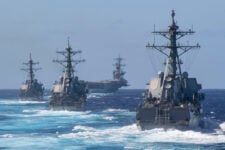The Theodore Roosevelt Carrier Strike Group transits the Pacific Ocean Jan. 25, 2020. (U.S. Navy photo by Mass Communication Specialist 2nd Class Jason Isaacs)
WASHINGTON — The Navy has charted two potential pathways ahead in its new 30-year shipbuilding strategy, according to a proposal submitted to lawmakers today: one that will require more funding that the Navy says is aligned with the 2023 Battle Force Ship Assessment and Requirement (BFSAR) report, and another “resource constrained” outlook that assumes no real annual spending growth.
The twin plans, described in a Navy document first reported by Politico and obtained by Breaking Defense, are largely identical in terms of total manned battle force ships through much of the next decade, with both reaching a low of 280 ships in fiscal year 2027.
But after FY33 the two start to diverge. According to the document, the BFSAR-aligned plan would see a fleet of 330 manned ships by the mid-2030s, and 377 ships by FY45. By comparison, the budget-constrained plan wouldn’t hit 330 ships until later in the 2030s, and in FY45 would have 343 ships.
The resource-constrained alternative shipbuilding plan also falls short of the total force the Navy has told Congress it needs to support the National Defense Strategy — 381 ships, according to USNI News. The strategy says the service would briefly achieve that figure with the better-funded plan in FY42 and FY43, before dipping to again rise above the 381 target in FY52 through the strategy’s final year of FY54. All told, the better-funded plan would peak at 387 ships in FY54. Conversely, the resource-limited plan would top out at 348 ships in FY42.
The two-option strategy follows the service’s previously proposed three potential ways forward for constructing its fleet, which earned the ire of lawmakers who viewed the move as indecisive.
Both of the current plans expect on-time and on-budget industry performance, the document notes. The two also keep a total force of 31 amphibious warfare ships across the 30-year timeframe, evidently heeding complaints from lawmakers that service officials were not adhering to requirements outlined by Congress. Marine Corps leadership admitted last year that a lack of ready ships prevented the service from responding to events around the globe, such as the civil and humanitarian crises in Turkey and Sudan.
The shipbuilding strategy further details needs for the submarine industrial base, which some lawmakers fear is being strained by the AUKUS agreement that plans to provide nuclear subs to Australia.
The Navy will need approximately $17.5 billion in additional funds between FY24 and FY29 to furnish capacity for “sustained production levels” of one Columbia-class and two Virginia-class subs by 2028, the document says. About $3.3 billion alone is contained in the $100-plus billion supplemental still stuck on Capitol Hill, with the rest spread out in current and future budget requests.
Of the 19 ships potentially destined for decommissioning in FY25, 10 will be retired early, with the other nine consisting of six combatant ships and three attack submarines that are at or exceed their expected service lives, the document says. The service’s $203.9 billion FY25 budget request unveiled last week called for buying just six new vessels — a net negative that lawmakers are already unimpressed by.











